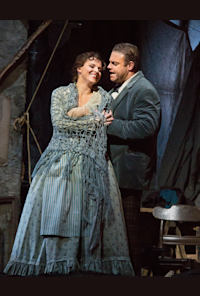La bohème by Puccini, P 29 nov 2021, No (2021/2022), Režisēja Franco Zeffirelli,, Diriģents Eun Sun Kim, Carlo Rizzi, Metropolitan Opera House, New York City, United States
Producents

Lincoln Center
Conductor
Stage director
Lomās
Mimì
(Mimi)

(2021 nov 09, 13, 17, 20, 26, 29; dec 03; 2022 jan 09, 22; mai 16, 20, 24, 27)
MA(2021 nov 20, 29; 2022 jan 09, 13, 18, 22; mai 16, 20, 24, 27)

(2021 nov 20, 29; 2022 jan 09, 22; mai 16, 20, 24, 27)
Rodolfo

(2021 nov 20, 29; 2022 jan 09, 22; mai 16, 20, 24, 27)
Musetta

(2021 nov 09, 13, 17, 20, 26, 29; dec 03; 2022 jan 09, 22; mai 16, 20, 24, 27)

(2021 nov 20, 29; 2022 jan 09, 13, 18, 22; mai 16, 20, 24, 27)
AK(2021 nov 20, 29; 2022 jan 09, 22; mai 16, 20, 24, 27)
Schaunard

(2021 nov 20, 29; 2022 jan 09, 22; mai 16, 20, 24, 27)
Colline

(2021 nov 09, 13, 17, 20, 26, 29; 2022 jan 09, 22; mai 16, 20, 24, 27)

(2021 nov 20, 26, 29; dec 03; 2022 jan 09, 22; mai 16, 20, 24, 27)

(2021 nov 20, 29; 2022 jan 09, 13, 18, 22; mai 16, 20, 24, 27)
NT(2021 nov 20, 29; 2022 jan 09, 22; mai 16, 20, 24, 27)
Benoît
Alcindoro
Marcello
AR(2021 nov 09, 13, 17, 20, 26, 29; 2022 jan 09, 22; mai 16, 20, 24, 27)
LM(2021 nov 20, 29; 2022 jan 09, 13, 18, 22; mai 16, 20, 24, 27)
JW(2021 nov 20, 29; dec 03; 2022 jan 09, 22; mai 16, 20, 24, 27)
QK(2021 nov 20, 29; 2022 jan 09, 22; mai 16, 20, 24, 27)
Radoša komanda
Set designer
Costume designer
Lighting designer
Librettist
Līdzproducents
Līdzproducents






